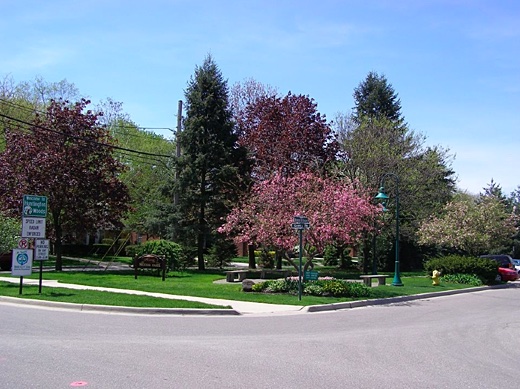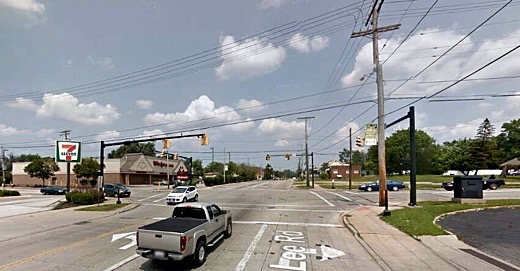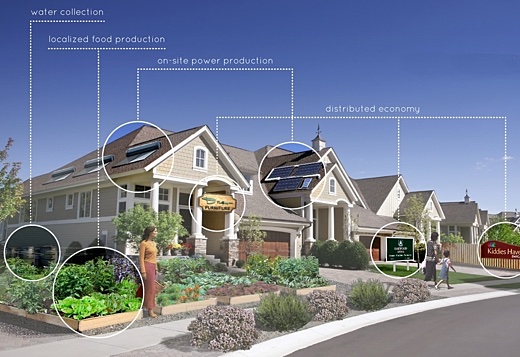SUBHEAD: Suburbia could be more self-sufficient, healthy, productive, and life-affirming than we know today.
By Morgan Maiolei on 21 July 2016 for Strong Towns -
(http://www.strongtowns.org/journal/2016/7/20/resilient-suburbia)

Image above: Huntington Woods, Michigan, ranked in top 20 suburbs in America by Business Insider. From (http://www.businessinsider.com/best-suburbs-in-america-2014-9?op=1).
This week, Strong Towns' members and readers respond to the questions: Is it possible and/or worthwhile to retrofit suburbia/big box stores, or would we be better off abandoning underused suburban spaces? How might we go about retrofitting big box stores for future use?
Here is Morgan Maiolie's answer.
It’s worth questioning whether it makes sense to expend our limited time, attention, and funds to retrofit what is certainly an expansive misallocation of resources. The suburbia we’ve built is costly to maintain in both infrastructure and energy.
It is an uncomfortable environment, poor in walkability and civic life, that sentences its denizens to ever-increasing hours of car commutes.
It generates a sedentary lifestyle and cuts rapaciously into valuable habitat, creating health impacts that transcend human communities to adversely affect other species (and which then, because we are part of an interconnected ecosystem, reverberate back to damage our own).
Suburbia’s cost, discomfort, and adverse health impacts make the case only that we should stop building in this way for the future, however. Whether we should leave the suburban investment we’ve already made is a different question altogether and my answer is a staunch, No.
Although it’s tempting to picture packing up and leaving suburbia to peacefully degrade, we shouldn’t. More, we wouldn’t like what would happen if we did.
Our economic markets are directly tied to suburbia’s success and to abandon it would be to collapse the financial system as we know it.
A great many members of our society have invested in this form of development, and, if it becomes untenable and its homes worthless, it would be impossible to finance the development of more sustainable urban forms; not to mention the hardship we’d bring upon a large segment of our society.
Jeff Vail calls this suburbia’s Catch-22: it isn’t possible to finance suburban alternatives because the credit markets that would do so are tied to suburbia’s longevity and value.
That we have no financial choice other than to ride out our investment in suburbia isn’t the only reason to keep it, however. Suburbia’s weaknesses are great, but surmountable, and its sprawling form might offer unique advantages.

Image above: Maple Heights is thought to be in the top ten worst suburbs of Cleveland, Ohio. From (https://www.roadsnacks.net/these-are-the-10-worst-cleveland-suburbs/).
Suburbia's Weaknesses
To begin, suburbia’s most glaring weakness as a car-dependent system may not be as intractable as we think. In his four-part series for The Oil Drum, Jeff Vail makes the convincing case that a willingness to accept slight inconvenience in the form of ridesharing, mass transit, biking and less frequent deliveries would make a significant enough reduction in the cost and greenhouse gas emissions of suburban transportation to overcome the benefits of leaving our suburban infrastructure behind.
A larger hurdle than transportation is the inherent energy inefficiency of suburbia’s loosely-spread form and large, detached buildings. Compared to denser, insolation-constrained urban development, however, suburbia stands to see much more dramatic gains from solar power innovation.
If advances in sustainable technology continue, suburbia could offset its inefficiency to our centralized systems by producing a greater amount of its own power.
Even if sustainable technology advances slow, the technologies we already have in solar hot water, passive heating and cooling, increasing insulation and demand-controlled ventilation are promising means for suburbia to reduce consumption and provide localized power to a majority of suburban homes and businesses.
Suburbia is also better-positioned than urbia to produce food locally, reducing its dependence on frequent, centralized food shipments. A carefully-tended 1/4th-acre suburban lot can realistically meet 25% of the caloric needs of a family of four.
Brad Lancaster, a master gardener working in the unforgiving climate of Tucson, Arizona, has seen much greater yields, turning a 1/6th-acre lot into a forest of food production using only rainwater and graywater.
Lancaster’s garden provides nearly half the food for his four-person family and, while this is not to say food production at that scale is easy, it implies that the rest of the country’s suburbs in more forgiving climates have significant growing potential.

Image above: Features of a revitalized American suburb featuring water collection, power generation, food growing, small manufacturing and a distributed economy. Illustration by Morgan Maiolei. From original article. Click to enlarge
Suburbia's Advantages
Moving beyond its weaknesses, suburbia’s decentralized form offers a unique advantage in economic innovation. Urban societies are coordinated, centralized systems that are structurally more dependent on top-down control, which tends to create barriers to innovation.
By contrast, suburbia is a decentralized rhizome of almost uniformly distributed dwelling and ownership. Such distributed systems have historically excelled at innovation.
In his book, Throwing Rocks and the Google Bus, Douglas Rushkoff relates that the decentralized mediaeval bazaar was such a powerful force of middle class growth and innovation that feudal lords created hierarchical corporations to quell it.
Distributed, non-hierarchical economic systems are powerful because they are chaotic but smart; what they lose in regularity, they gain in unimpeded, open-source production.
Combine this with modern technology's ability to connect us to new ideas and expand our capacity for fabrication through 3D printing and open-source plans (see: 100,000 Garages), and a future begins to take shape that elevates suburbia above an urban center’s bedroom community to a unique economic engine in its own right.
Suburbia already has many of the characteristics to support a distributed society of makers. Its form is one of ample space; lawns for gardening, garages for building, and enough residential square footage to spare for commercial enterprise and denser living.
I am writing from New Orleans, where many historic homes too expensive for single family occupancy have been converted to businesses and multifamily dwellings. It’s not a stretch to picture the same transition in suburban McMansions if the right market signals are in place.
Suburbia also offers large, flexible big boxes in spades. Where big box stores are currently utilized by a car culture of large-scale, one-stop consumerism, their innate flexibility gives them the ability to transition to hubs of local production and civic space.
In this context, big boxes could constitute the physical framework for community cooperatives to compliment individual, distributed business.
Big box stores can easily, and in many cases have already, been reimagined as libraries, schools, shared workshops, fabrication facilities, and year-round farmer’s markets. The U.S. has seen over a dozen big box Walmarts transition to churches.
When we picture a retrofit of suburban development, we often picture its conversion to a New Urbanist paradise; former suburban sprawl densified into an 1800s-esk town center surrounded by close-knit neighborhoods that follow the same economic model as the urban behemoth they were built to serve.
But to take suburbia back in time is a failure of imagination. We would do better to address suburbia’s weaknesses in transportation, energy efficiency, and health without throwing away the economic opportunities its form provides.
If we capitalize on suburbia’s strengths and think creatively about its evolution, we could position it as a form of development much more self-sufficient, healthy, productive, and life-affirming than the suburbia we know today.
Note: This article is informed to a large extent by Jeff Vail’s prescient and insightful presentation, Rescuing Suburbia, delivered at the 2010 ASPO-USA conference in Washington, D.C. You can watch Vail’s presentation at PeakOil.org and read his summary and slides at Resilience.org.
.
By Morgan Maiolei on 21 July 2016 for Strong Towns -
(http://www.strongtowns.org/journal/2016/7/20/resilient-suburbia)

Image above: Huntington Woods, Michigan, ranked in top 20 suburbs in America by Business Insider. From (http://www.businessinsider.com/best-suburbs-in-america-2014-9?op=1).
This week, Strong Towns' members and readers respond to the questions: Is it possible and/or worthwhile to retrofit suburbia/big box stores, or would we be better off abandoning underused suburban spaces? How might we go about retrofitting big box stores for future use?
Here is Morgan Maiolie's answer.
“It’s worth questioning whether it makes sense to expend our limited time, attention, and funds to retrofit what is certainly an expansive misallocation of resources.”Talented designers and planners have shown us that it’s possible to retrofit suburbia. Although the scale at which we’ll be able to do this has yet to be seen, that it can be accomplished is clear. A more interesting question, and the one I want to tackle, is “How should we retrofit suburbia?” but, first, I’ll briefly address why we should bother in the first place.
It’s worth questioning whether it makes sense to expend our limited time, attention, and funds to retrofit what is certainly an expansive misallocation of resources. The suburbia we’ve built is costly to maintain in both infrastructure and energy.
It is an uncomfortable environment, poor in walkability and civic life, that sentences its denizens to ever-increasing hours of car commutes.
It generates a sedentary lifestyle and cuts rapaciously into valuable habitat, creating health impacts that transcend human communities to adversely affect other species (and which then, because we are part of an interconnected ecosystem, reverberate back to damage our own).
Suburbia’s cost, discomfort, and adverse health impacts make the case only that we should stop building in this way for the future, however. Whether we should leave the suburban investment we’ve already made is a different question altogether and my answer is a staunch, No.
Although it’s tempting to picture packing up and leaving suburbia to peacefully degrade, we shouldn’t. More, we wouldn’t like what would happen if we did.
Our economic markets are directly tied to suburbia’s success and to abandon it would be to collapse the financial system as we know it.
A great many members of our society have invested in this form of development, and, if it becomes untenable and its homes worthless, it would be impossible to finance the development of more sustainable urban forms; not to mention the hardship we’d bring upon a large segment of our society.
Jeff Vail calls this suburbia’s Catch-22: it isn’t possible to finance suburban alternatives because the credit markets that would do so are tied to suburbia’s longevity and value.
That we have no financial choice other than to ride out our investment in suburbia isn’t the only reason to keep it, however. Suburbia’s weaknesses are great, but surmountable, and its sprawling form might offer unique advantages.

Image above: Maple Heights is thought to be in the top ten worst suburbs of Cleveland, Ohio. From (https://www.roadsnacks.net/these-are-the-10-worst-cleveland-suburbs/).
Suburbia's Weaknesses
To begin, suburbia’s most glaring weakness as a car-dependent system may not be as intractable as we think. In his four-part series for The Oil Drum, Jeff Vail makes the convincing case that a willingness to accept slight inconvenience in the form of ridesharing, mass transit, biking and less frequent deliveries would make a significant enough reduction in the cost and greenhouse gas emissions of suburban transportation to overcome the benefits of leaving our suburban infrastructure behind.
A larger hurdle than transportation is the inherent energy inefficiency of suburbia’s loosely-spread form and large, detached buildings. Compared to denser, insolation-constrained urban development, however, suburbia stands to see much more dramatic gains from solar power innovation.
If advances in sustainable technology continue, suburbia could offset its inefficiency to our centralized systems by producing a greater amount of its own power.
Even if sustainable technology advances slow, the technologies we already have in solar hot water, passive heating and cooling, increasing insulation and demand-controlled ventilation are promising means for suburbia to reduce consumption and provide localized power to a majority of suburban homes and businesses.
Suburbia is also better-positioned than urbia to produce food locally, reducing its dependence on frequent, centralized food shipments. A carefully-tended 1/4th-acre suburban lot can realistically meet 25% of the caloric needs of a family of four.
Brad Lancaster, a master gardener working in the unforgiving climate of Tucson, Arizona, has seen much greater yields, turning a 1/6th-acre lot into a forest of food production using only rainwater and graywater.
Lancaster’s garden provides nearly half the food for his four-person family and, while this is not to say food production at that scale is easy, it implies that the rest of the country’s suburbs in more forgiving climates have significant growing potential.

Image above: Features of a revitalized American suburb featuring water collection, power generation, food growing, small manufacturing and a distributed economy. Illustration by Morgan Maiolei. From original article. Click to enlarge
Suburbia's Advantages
Moving beyond its weaknesses, suburbia’s decentralized form offers a unique advantage in economic innovation. Urban societies are coordinated, centralized systems that are structurally more dependent on top-down control, which tends to create barriers to innovation.
By contrast, suburbia is a decentralized rhizome of almost uniformly distributed dwelling and ownership. Such distributed systems have historically excelled at innovation.
In his book, Throwing Rocks and the Google Bus, Douglas Rushkoff relates that the decentralized mediaeval bazaar was such a powerful force of middle class growth and innovation that feudal lords created hierarchical corporations to quell it.
Distributed, non-hierarchical economic systems are powerful because they are chaotic but smart; what they lose in regularity, they gain in unimpeded, open-source production.
Combine this with modern technology's ability to connect us to new ideas and expand our capacity for fabrication through 3D printing and open-source plans (see: 100,000 Garages), and a future begins to take shape that elevates suburbia above an urban center’s bedroom community to a unique economic engine in its own right.
Suburbia already has many of the characteristics to support a distributed society of makers. Its form is one of ample space; lawns for gardening, garages for building, and enough residential square footage to spare for commercial enterprise and denser living.
I am writing from New Orleans, where many historic homes too expensive for single family occupancy have been converted to businesses and multifamily dwellings. It’s not a stretch to picture the same transition in suburban McMansions if the right market signals are in place.
Suburbia also offers large, flexible big boxes in spades. Where big box stores are currently utilized by a car culture of large-scale, one-stop consumerism, their innate flexibility gives them the ability to transition to hubs of local production and civic space.
In this context, big boxes could constitute the physical framework for community cooperatives to compliment individual, distributed business.
Big box stores can easily, and in many cases have already, been reimagined as libraries, schools, shared workshops, fabrication facilities, and year-round farmer’s markets. The U.S. has seen over a dozen big box Walmarts transition to churches.
When we picture a retrofit of suburban development, we often picture its conversion to a New Urbanist paradise; former suburban sprawl densified into an 1800s-esk town center surrounded by close-knit neighborhoods that follow the same economic model as the urban behemoth they were built to serve.
But to take suburbia back in time is a failure of imagination. We would do better to address suburbia’s weaknesses in transportation, energy efficiency, and health without throwing away the economic opportunities its form provides.
If we capitalize on suburbia’s strengths and think creatively about its evolution, we could position it as a form of development much more self-sufficient, healthy, productive, and life-affirming than the suburbia we know today.
Note: This article is informed to a large extent by Jeff Vail’s prescient and insightful presentation, Rescuing Suburbia, delivered at the 2010 ASPO-USA conference in Washington, D.C. You can watch Vail’s presentation at PeakOil.org and read his summary and slides at Resilience.org.
.
No comments :
Post a Comment